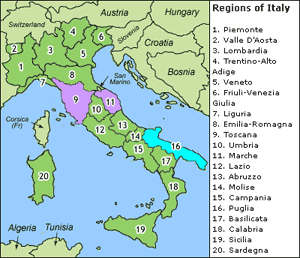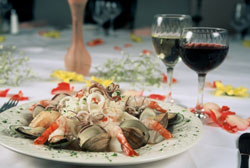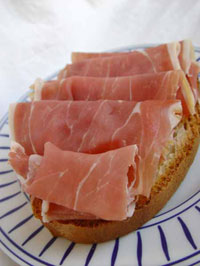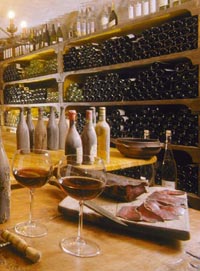|
ABOUT ITALY
Italy is situated in Mediterranean Europe and shares its frontiers with France in the north-west, with Switzerland and Austria in the north and Slovenia in the north-east. Italy also shares the sea boundary with Croatia and France.
The Republic of San Marino and Vatican City are two independent countries within the borders of Italy.
The total area of 116,303 square miles comprises the peninsula with the Apennines, two islands Sicily and Sardinia and the mountain range of Alps in the north. The vast Po plain stretches at the foot of the Alps, with the longest river in Italy which flows into the Adriatic.
Italy is surrounded by the Adriatic sea, the Ionian sea, the Tyrrhenian sea and finally by the Ligurian sea.
The northern part is famous for its lakes; Maggiore, Como, Iseo and Garda, while the central Italy is distinguished by its hilly landscape with two major rivers; Tevere and Arno.
Further to the south we come to Gargano promontory and the Salentine peninsula. Italy boasts with several archipelagos; the Tremiti Islands in the Adriatic Sea, the Tuscan Archipelago, the Pontine Islands, the Aeolian Islands and the Egadi Islands in the Tyrrhenian Sea.
It is the land of arts, culture, tradition and one of the most popular vacation countries.
Its rich historical heritage and natural beauty, green hills, olive groves, medieval villages...attract tourists from all over the world. Italy is one of the most prosperous countries in Europe and there is place for everyone here, whether it would be relaxing on a beach, walking in fantastic countryside, an active break skiing or watersports, or enjoying art and architecture.
GENERAL INFORMATION
Population: 56,778,000
Capital:
Rome (2,775,000 inhabitants)
Language:
Italian, and minorities speaking German, French, English
Dialing code :
39
Time zone: Central European Time
Regions: Italy is divided into 20 regions, each unique and interesting in its own way:

- Abruzzo is a land of antique crafts, of fishermen, farmers and shepherds. The National Park of Abruzzo is the habitation of bears, wolves, dears, chamois, otters and other animals. Aquila is its capital and historical center.
- Aosta Valley with its unique scenery, fields and vineyards, pasture ground, rocks and cascades covered with ice during the winter. Rock climbing was born here, followed by tourism and sport activities. It is the smallest region in Italy, therefore less populated and it enjoys the autonomous status. It's characterized by continental dry climate, harsh weather in higher region, mild in valley.
- Apulia (Puglia) is a promised land for many. It is a field of olives, orchards, vineyards...an agricultural land indeed. It's characterized by the mediterranean climate with calm weather.
- Basilicata is mostly mountain region sloping down to the small coastal part of the Ionian sea. Its mediterranean climate vary, mostly with cold winter and pleasant autumn and spring.
- Calabria is a peninsula mostly mountain which once made the communication rather difficult. Its high and rocky coast, places on the top as well as on the foot of the hills, diversity of landscape, hospitality...all make this region more magnificent. It's characterized by the combination of the mediterranean climate and the continental one.
- Campania is the region famous for the ancient city of Pompei and the volcano Vesuvius, beautiful and sunny region. Not only its mediterranean climate is favourable for summer tourism, but for winter tourism as well. Napels is its capital city whose name means the new city.
- Emilia – Romagna is the region of hills and long valleys, famous for parmesan, potatos, wheat, and not only. It is the region of art as well. It conects the southern part of the Padan plain with the slope of the Apennines. It has the continental climate with hot summers and cold winters.
- Friuli - Venezia Giulia – this whole region is a land of confines, interlaced with facts, people, migrations...Trieste is the capital city of three different cultures. The area is characterized by strong winds (bora), cold winters, continental climate.
- Latium (Lazio) with the diversity of landscape, arts and surroundings. It's characterized by the mediterranean climate with pleasant spring and autumn. Rome is its main center, the most populated city in Italy and its capital city as well. It is the center of culture, politics and tourism. Its area comprises the Vatican City, the independent papal residence.
- Liguria - cultivated with lavender, rosemary, olives and walnut behind the coastal belt. Besides, people here have always been traders and sailors. Therefore, this is one of the most developed regions in Italy. Here you will find the beautiful town Genova, interesting architecture, sense of art and special relation to the sea
- Lombardy with its specific landscape of lakes, neoclassical villas with their gardens, many beautiful resorts. Its main center is Milan, an energetic town of affairs, production and arts as well. This region is characterized by the continental climate which vary depending on the altitude, sun exposure, lakes...
- Marche is a land of magnificent panorama with small places on the hills and rich valleys between them, the whole landscape of hills sloping towards the sea.
- Molise is the region of mountains and hills, the region of sheperds, vineyards and olive groves with the capital city of Campobasso.
- Piedmont (Piemonte) is a colorful region famous for castles and vineyards, lakes, antique villas with beautiful parks. Torino is the major center which has been the capital city for centuries. The name of the region means the foot of the mountain and it indicates the small part of the plain between the river Po and Sangone. It is the second largest region in Italy, characterized by continental climate with cold winters.
- Sardinia is an island of extreme beauty and nature, a real colorful island. It is the second largest mediterranean island with almost 1900 km of coast.
- Sicily – an impact of different cultures left traces on this beautiful island. It is the largest mediterranean island, 3 km distant from the peninsula. It's famous for the active volcano Etna and many splendid islets.
- Trentino - Alto Adige is a mountain region with numerous castles, vineyards and orchards, characterized by the diversity of culture and languages where people wear traditional costumes in some parts. The mountain climate with mild winters is convenient for winter sports.
- Tuscany (Toscana) – with beaches shaped like a sickle, islands in a distance, olive groves, cypresses that inspired many artists. The region, formed like a triangle, is characterized by the mediterranean climate along the coast combined with the continental one in the inland.
- Umbria – «green» and «mystical», these terms can be attributed to its name. It is the region with strong religious belief and medieval image. It is the only peninsular region surrounded by the land, with the mediterranean climate, the rainy region with mild summer.
- Veneto – its country rich in splendid villas reflecting nobleness and magnificent architecture. Its name derives from the inhabitants of the preromanic period (veneti). In spite of its continental climate this area has mild winters. Its main center is Venice, constructed on more than a hundred islets with over 400 bridges. It is the unique town indeed...
HISTORY
Due to its geographical position, Italy has experienced many invasions and has been home to different civilizations; Greeks established their colonies in the south, Etruscans settled in the central part, and Gauls in the north.
Rome was founded on April 21, 753 BC and was first ruled by kings until it became the republic of consuls. In 29 BC the Roman Empire was born when Octavius declared himself the Emperor Augustus. The long Roman domination left significant mark in Italy; roads, aqueducts, temples, monuments, bridges, theatres and cities.
After the fall of the Roman Empire, in spite of many city states, Rome, which was home to the Catholic church, still remained the most powerful city.
These independent city states led to the prosperity of Italy which became flourishing and civilized country of trade. However, they could not hold out against Spanish and Austrian invasion.
In 1870 the great movement led to the unification of Italy under the Royal House of Savoia into the Kingdom of Italy. After World War II, Italy abolished the monarchy which resulted with the creaton of the Italian Republic in 1946.
Italy influenced the development of the whole Mediterranean and European culture as well. It was central to European science and art during the Renaissance. Now, Italy is one of the most prosperous and democratic nations in Europe.
CLIMATE
Geographical position of Italy causes considerable weather differences between northern mountain region and plains in the south. Local weather conditions depend on altitude and coastal effects. Though the northern part is protected by the mountain range, temperatures sometimes drop below zero in winters, while temperatures in the south never get severe drops. Mountain areas are rather colder with severe, long winters. However, hot air from the coast causes thunderstorms in the mountains, thus causing the great change between the seasons.
Towards the south along the mountain range of the Apennines, these regions are characterized by mild climate all year round for they are protected by hills and mountains.
The rest has a pleasant climate with long, hot summers and mild winters.
Rainfall is higher in the north, while hot and dry African winds keep humidity down in the southern parts. Cooler winds from the north often bring rain and storms.
Generally speaking, Italy has favourable climatic conditions, Mediterranean climate with long, hot summers, mild winters, sunny springs and autumns.
Not only Italy has become a popular summer destination, but it is gaining popularity with winter visitors as well thanks to its splendid alpine resorts.
GASTRONOMY
 The Italian cuisine is known worldwide and famous for its diversity, healthy balance, flavoured ingredients, always inspired to be more inventive in preparing meals. The Italian cuisine is known worldwide and famous for its diversity, healthy balance, flavoured ingredients, always inspired to be more inventive in preparing meals.
There is a great difference between northern and southern cuisine in Italy, implying mostly to the pasta varieties.The first one, slightly influenced by French and German cuisine, using more butter, cream, Mascarpone cheese, rise and fresh egg pasta, while the latter one favors Mozzarella cheese, olive oil, dried pasta and tomato.
 As already mentioned, the Italian cuisine is pretty much known for its diversity and each part of the country boats with variety of flavors and local delicacies. As already mentioned, the Italian cuisine is pretty much known for its diversity and each part of the country boats with variety of flavors and local delicacies.
Therefore, Emilia-Romagna can be distinguished by lasagna, tortellini, mortadella, prosciutto (smoked ham), parmigiano (Parmesan cheese). Piemonte and Lombardia grow different kinds of rice.
The Tuscan cuisine favors white beans, meat and bread without salt.The Roman cuisine uses a lot of sheep cheese and organic meat, and is known for its thin pizza in distinction from the Napoletan and Sicilian pizza which is thicker.
Naples is famous not only for its pizza, but for mozzarella and pastries as well.
Calabria then with its salumi and hot pepper, famous icecream of Sicily with its cuisine influenced by the Arab one, and finally Sardinia famous for its lamb and pecorino.
 Italians pay much attention to food, service and the ambient. One can eat in restaurants, fancy places rather expensive, or in trattoria where local speacialties are usually served, bars then with quick meals and finally pizzeria. Italians pay much attention to food, service and the ambient. One can eat in restaurants, fancy places rather expensive, or in trattoria where local speacialties are usually served, bars then with quick meals and finally pizzeria.
Italians prepare usually light breakfast with cappuccino and a sweet pastry, or simply espresso.
Lunch is rather important and consists of antipasto, then primo piatto with pasta, rice or soup, secondo piatto with meat or fish with vegetable or salad, then fresh fruit.
They usually finish with espresso, black strong coffee or maybe a grappa or amaro (liqueur).
Dinner is similar to lunch.
Besides all these delicacies, Italy is a wine growing nation as well thanks to its climate, old tradition in viticulture and rich soil.
CULTURE AND EVENTS
Italian tradition and customs, influenced by other countries and civilizations on this territory contributed to cultural and historical heritage of Europe. It has always been artistic and intellectual center that led to many great cultural achievements, specially art through works of Michelangelo, Da Vinci, Tintoretto, Caravaggio, Botticelli and many others with their masterpieces hidden in churches across the country. We must not forget achievements in literature, science and music as well.
Modern Italian language which was established through Dante Alighieri with his master-piece Divina Commedia, was means of expression for many literary figures: Boccaccio, Pirandello, Tasso, Leopardi, Ariosto, Machiavelli...
Science, on the other hand, resulted with prominent names; Galileo Galilei, Leonardo Da Vinci, Fermi, Volta, Meucci and others.
As to the music, it has always been important in Italian culture. Having provided foundations for classical music tradition, Italy gave birth to opera. Also, some instruments often associated to classical music were invented in Italy, such as piano and violin. The most famous composers: Palestrina, Monteverdi, Paganini, Vivaldi, Puccini...
When in Italy, one can attend many different cultural and historical events:
- Pre-Easter Carnival in Venice
- Holy Week Easter processions in Taranto, Chieti, Sicily and Florence
- Festivals honouring patron saints are particularly colourful events
- Festa di San Nicola in Bari and San Gennaro in Naples
- Festival of Snakes in Abruzzo (May)
- Festa of Sant'Antonio in Padua (June).
- Race of the Candles and Palio of the Crossbow in Gubbio (May)
- Sardinian Cavalcade (May)
- Regata of the Four Ancient Maritime Republics (which rotates between Pisa, Venice, Amalfi and Genoa, and is held in June)
- Il Palio in Siena (July & August)
- Venice's Historic Regatta (September)
|